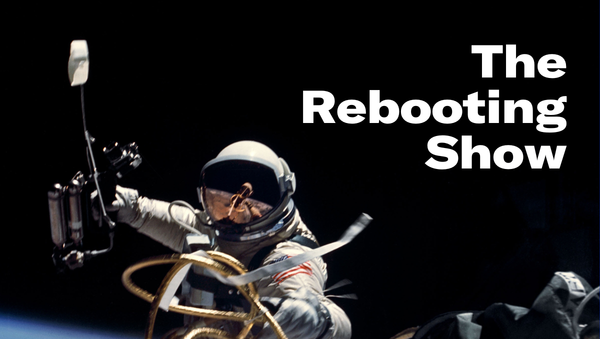Newsletter growth
Substack's Reid DeRamus on newsletter growth engines and a report from CES
I’m heading out tonight for a trip to Munich to speak at the DLD Conference, where I’ll be talking about what a year of reset expectations means for publishing and giving a workshop at Burda. Looking forward to both. If you happen to be in Munich, let me know: bmorrissey@therebooting.com.
This week, some thoughts on a quick 36 hours at CES, a new podcast with Substack growth guru Reid DeRamus and why 2023 is going to be the year of AI hype (and likely some reality). First, a message from Omeda.

Too often in digital media, quantity has trumped quality. That holds true for user data. More data isn’t better data, it’s just more data. In fact, bad data isn’t just low value, it’s costly. According to a survey by Gartner, organizations believe poor data quality to be responsible for an average of $15 million per year in losses. Even worse, nearly 60% of those surveyed didn't know how much bad data costs their businesses – or how to fix it -- because they don't measure it in the first place. Understand whether you have a “bad data” problem – and the steps you can take to improve your data strategy to prioritize data quality over quantity.

CES Report: Year of the grind
I spent a few days in Las Vegas last week at CES. Thanks to Outbrain for supporting the first Rebooting event, a gathering of about 100 people at the Aria. I had a great conversation with GroupM’s Krystal Olivieri on the issue of advertisers not bailing on news. Thanks to everyone who came out. I plan to do more of these events, in New York and other places.
Talking to people in Vegas, a couple themes emerged. One is that in-person gatherings aren’t going anywhere. The shift to virtual events heralded by the pandemic was one of the more overrated bubbles of that time. (I’m not blameless, my evaluation of the future of events post-Covid was probably off in key aspects.) It is simply human nature to want to gather with others, including those you do business with.
One of the oddities of CES is that there are many universes. The media and advertising communities are clumped around the Aria and the Cosmopolitan. For how sprawling Vegas is and how big CES is – over 100,000 people officially attended, although many more skulked about hotel lobbies without ever encountering the actual event – if you walked into the lobby of the Aria it wouldn’t take long to run into someone you know from this industry. That’s valuable and doesn’t get replaced by Zoom.
One of the things I liked about the event I held with Outbrain was that it was casual and not held in one of the terrible hotel ballrooms with those awful carpets. I don’t have a lot of hard and fast rules about the types of events I want The Rebooting to do, but one is no awful hotel carpets. Maybe I was traumatized looking at them so many times over the years. That said, I believe we’ll see people being choosier with their time. I’m continuously amazed at the sheer number of events this industry supports. One reason for my own hesitancy in jumping into in-person gatherings has been understanding an unmet need. My conclusion is the opportunity is in smaller, more focused and higher level gatherings that are focused on the audience rather than serve as an excuse for straight sales pitches.
The other key theme was this year will be a grind. It came up time and again in conversations. Most expected a rough year ahead thanks to the economy, but there was also a confidence born of getting through the early pandemic collapse and navigating a difficult stretch. And any downturn in 2023 will just continue a tail off of 2022. Many publishers missed their numbers in 2022. Vice missing revenue forecast by $100 million isn’t an outlier. According to the new Reuters Institute report, 44% of publishing executives expressed confidence in the year ahead, a 31 point decrease in positive sentiment compared to last year. Of particular concern: news avoidance. On the last one, who can blame people considering the catastrophism that has defined much coverage.

Calling all publishers. As your team ramps up branded and commerce content campaigns for advertisers this year, you may wonder how you measure up to your competitors. With Pressboard, you can easily measure the success of your sponsored content, ecommerce, and social media campaigns to wow your advertisers. Check out the most recent Benchmark Report to see how your content measures up to the rest of the industry.

Growth
Publishing isn’t that complicated of a business. You create content for a specific, hopefully high-value audience, your find ways to distribute that content to your audience, you make money by selling ads to reach the audience or selling subscriptions or products to the audience. The middle part is critical: Growth.
These basic mechanisms – create, grow, sell – underpin the publishing function. And they’ve long required what’s become a fair sophisticated infrastructure to pull off. The shift from institutions to individuals is a real trend, only the challenge for many going solo lies primarily in growth. In newsletters specifically this challenge can be overcome by pouring money into ads, which many of the most popular newsletters have done quite a bit, while also finding other levers for growth, whether it’s referral programs or recommendation engines.
This week on The Rebooting Show, I spoke to Substack’s Reid DeRamus about growing newsletter audiences. Reid and I have spoken for the past two years on this topic, going back to before Substack bought his company Yem, which was focused on building a growth engine for newsletter writers. The thing about growth, at least I’ve found, is it takes a long time for most people. It’s taken me over two years to get 12,700 subscribers. I always tell people to take with a grain of salt the overnight success stories of newsletters that amass 250,000 subscribers in less than a year. They are remarkable because they are unusual, and the people running them are likely experts in marketing while most of us writing are not.
Recommendations is Substack’s No. 1 feature it has rolled out. It needed to provide that distribution function to publishers. Otherwise it would just be a newsletter CMS with Stripe integration. Recommendations are now responsible for 40% of new free subscriptions to Substack-hosted publications. Reid and I discussed that dynamic and other features Substack is rolling out to increase the number of people who covert to paid subscribers.
Reid calls these features together as having “your own growth team.” The test of the durability of the solo model will be in whether these kinds of tools and services develop fast enough in order to provide operators with the ability to level the playing field with institutional publishers that have entire teams devoted to important publishing functions like growth.
Subscribe to The Rebooting Show on Apple or Spotify. Also, check out Reid’s new newsletter, Growth Croissant, to nerd out on all kinds of newsletter growth issues.

Recommendations
The problem with most overhyped trends is there is a real shift happening, only it tends to be taken so far. Take WeWork. They were very right on the changing nature of work and the office, only the execution, well, the company is now down 98% of its valuation from its peak. The same will hold true with the creator economy. There is a shift from institutions to individuals that is lasting, only the size of the market – and the sheer numbers of people able to make a good living solo – is likely far smaller than many well-funded creator economy startups expected.
Wade Wallace plans to launch a new membership-based cycling media property. Wade is the founder of Cycling Tips, which Outside acquired in 2021. The opportunity he sees is to build on the tight-knit cycling community with a model that puts members at the forefront and skips the SEO and traffic games that have defined a lot of publishing in the prior era.
Punchbowl is probably the most successful new publishing launches of the past several years. The execution has been close to flawless – and the timing wasn’t bad either, considering the world attention focused on the Capitol a few days after Punchbowl’s launch to obsessively cover Capitol Hill. Punchbowl’s deeply embedded in Washington is an easy excuse for rivals to take potshots, but it’s also what the publication brings to the table. Jake Sherman’s Twitter feed was probably the best way to follow the chaotic Speaker election last week.
The mania over streaming produced many oddities, and Cheddar was one of them. The streaming news service from former BuzzFeed top executive Jon Steinberg was seemingly everywhere at once. I was often asked just who is watching Cheddar exactly. Now owned by Altice, those questions are being asked in earnest as it goes through what Insider paints as an “identity crisis” as it determines the path between social video fare and a bare bones CNBC.
Just accept it now: 2023 will be the year of AI. Forget about Web3 and VR and the rest, the new gold rush is going to be in what’s sure to be a flood of generative artificial intelligence tools coming to the market. Microsoft plowing $10 billion into ChatGPT maker OpenAI is a sign of things to come. There’s a good case to pump the brakes on breathlessness over how far along AI is – it can sometimes be a not-very-smart person’s conception of what a smart person sounds like – but it’s hard not to conclude it will be baked into most products. This is going to bring up a host of thorny issues – and should provide a respite from endless litigation of social issues and bickering between tech types and The Media. Let’s hope.
It will also be the year of efficiency, as everyone learns to do more with less. With Impact.com’s Trackonomics, publishers can streamline their commerce operations. Learn five ways you can squeeze more revenue out of your commerce content. (Sponsored)

Thanks so much for reading. I’m always interested in hearing feedback. Send me an email at bmorrissey@therebooting.com.




